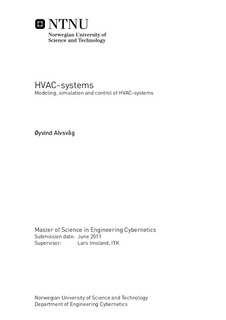| dc.contributor.advisor | Imsland, Lars | nb_NO |
| dc.contributor.author | Alvsvåg, Øyvind | nb_NO |
| dc.date.accessioned | 2014-12-19T14:04:04Z | |
| dc.date.available | 2014-12-19T14:04:04Z | |
| dc.date.created | 2011-09-23 | nb_NO |
| dc.date.issued | 2011 | nb_NO |
| dc.identifier | 443180 | nb_NO |
| dc.identifier | ntnudaim:5950 | nb_NO |
| dc.identifier.uri | http://hdl.handle.net/11250/260435 | |
| dc.description.abstract | It is of interest for companies to keep the annual operating cost of their buildings as low as possible. A substantial share of the annual operating costs are due to the large amount of energy needed for heating of the ventilated air and heating of the rooms inside the buildings. Also much of the electrical energy in the world today is created using fossil fuel or charcoal. This has an environmental aspect and the consumers of energy becomes more and more aware of this. Thus reducing the energy used by a buildings HVAC system can save the users for considerable expenditures and also has an environmental aspect.To find an estimate of the energy consumption a mathematical model representing a building and its HVAC system have been made. This model has been made up of several smaller models representing each component present in the building. These models have then been implemented in verb|Simulink| and the response of the system has been simulated for different scenarios. From these simulations the energy consumption has been extracted and compared to each other. Thus the amount of energy saved for each scenario has been found. The models include two type of controllers to see whether or not the choice of controller design affects the energy efficiency of the system. These two controller designs are the PID controller and the MPC control scheme. Also a discretized and simplified model of the building to be used together with the MPC controller has been found using system identification. In addition to this a Kalman filter that estimates unknown states and filter out disturbances are included in the MPC control scheme.The results from the simulations using a PID controller indicates a possible annual saving of substantial amounts. Thus this report shows that the annual energy consumption in a building can be greatly reduced by introducing simple and relatively cheap modifications to the HVAC system. The results from the simulations using the MPC scheme indicates that even more energy can be saved using this advanced control scheme. However, in order to verify this the MPC controller needs to be fine tuned and several more experiments needs to be reviewed. | nb_NO |
| dc.language | eng | nb_NO |
| dc.publisher | Institutt for teknisk kybernetikk | nb_NO |
| dc.subject | ntnudaim:5950 | no_NO |
| dc.subject | MTTK teknisk kybernetikk | no_NO |
| dc.subject | Reguleringsteknikk | no_NO |
| dc.title | HVAC-systems: Modeling, simulation and control of HVAC-systems | nb_NO |
| dc.type | Master thesis | nb_NO |
| dc.source.pagenumber | 266 | nb_NO |
| dc.contributor.department | Norges teknisk-naturvitenskapelige universitet, Fakultet for informasjonsteknologi, matematikk og elektroteknikk, Institutt for teknisk kybernetikk | nb_NO |

